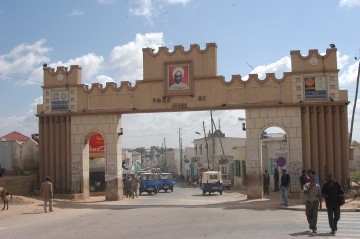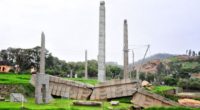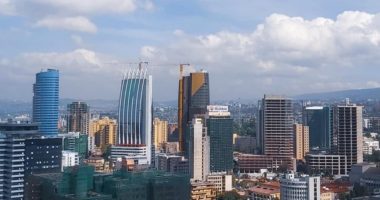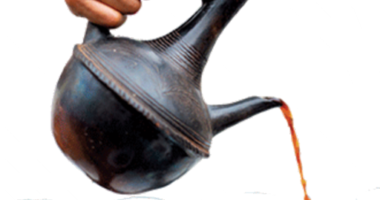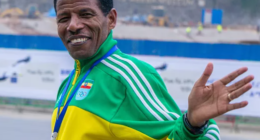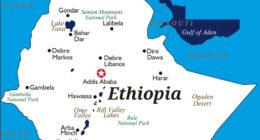Ethiopia is the oldest independent country in Africa and one of the oldest in the world. What are believed to be the oldest remains of a human ancestor ever found, which have been dated as being some five million years old, were discovered in the Awash Valley in Ethiopia. This beats the discovery of “Lucy”, a 3.2 million year old skeleton, who was unearthed in the same area in 1974.
The Greek historian Herodotus, of the fifth century BC, describes ancient Ethiopia in his writings, while the Bible’s Old Testament records the Queen of Sheba’s visit to Jerusalem where “she proved Solomon with hard questions”. Matters clearly went further than that because legend asserts that King Menelik – the founder of the Ethiopian Empire – was the son of the Queen and Solomon.
Remains of the Queen of Sheba’s palace can still be seen today in Axum, in the province of Tigray, northern Ethiopia. Axum is also home to many other extensive historical sites, including the home of the Ark of the Covenant, brought there from Jerusalem by Menelik.
Missionaries from Egypt and Syria reached Ethiopia in the fourth century and introduced Christianity. In the seventh century, the rise of Islam meant Ethiopia was then isolated from European Christianity. The Portuguese re-established contact with Ethiopia in the 1500s primarily to strengthen their control over the Indian Ocean and to convert Ethiopia to Roman Catholicism. A century of religious conflict followed resulting in the expulsion of all foreign missionaries in the 1630s.
This period of bitter conflict contributed to Ethiopian hostility towards foreign Christians and Europeans which persisted until the twentieth century and was a factor in Ethiopia’s isolation until the middle of the nineteenth century.
From the 1700s, for roughly 100 years, there was no central power in Ethiopia. This “Era of the Princes” was characterized by the turmoil caused by local rulers competing against each other. In 1869, however, Emperor Tewodros brought many of the princes together, and was a significant unifying force. He was succeeded by Emperor Yohannes, who built upon the efforts made by Tewodros, as well as beating off invasion attempts by the Dervish and the Sudanese.
Emperor Menelik II reigned from 1889 to 1913, fending off the encroachment of European powers. Italy posed the greatest threat, having begun to colonize part of what would become its future colony of Eritrea in the mid-1880s. In 1896 Ethiopia defeated Italy at the Battle of Adwa, which remains famous today as the first victory of an African nation over a colonial power.
In 1916, the Christian nobility deposed the sitting king, Lij Iyassu because of his Muslim sympathies and made his predecessor’s, (King Menelik 11 1889 – 1913), daughter, Zewditu, Empress. Her cousin, Ras Tafari Makonnen (1892-1975) was appointed regent and successor to the throne.
Zewditu died in 1930, after which the regent – adopting the name Haileselassie – became Emperor. His reign was interrupted in 1936 when Italian forces briefly invaded and occupied Ethiopia. Haileselassie then appealed to the League of Nations, but that appeal fell on deaf ears and he fled to exile in the UK, where he spent five years until the Ethiopian patriotic resistance forces with the help of the British defeated the Italians and he returned to his throne.
Haileselassie then reigned until 1974 when he was deposed and a provisional council of soldiers (the Derg, meaning committee) seized power and installed a government which was socialist in name and military in style. Fifty nine members of the Royal Family and ministers and generals from the Imperial Government were summarily executed. Haile Selassie himself was strangled in the basement of his palace in August 1975.
Major Mengistu Haile Mariam assumed power as head of state and Derg chairman after having his two predecessors killed. His years in office were marked by a totalitarian style government and the country’s massive militarization financed and supplied by the Soviet Union and assisted by Cuba. The brutality of the regime over a period of 17 years – aided by droughts and famine – hastened the Derg’s collapse.
Insurrections occurred throughout Ethiopia, particularly in the northern regions of Tigray and Eritrea. In 1989, the Tigrayan People’s Liberation front (TPLF) merged with the Amhara and Oromo liberation fronts (EPDM & OPDO) to form the Ethiopian Peoples’ Revolutionary Democratic Front (EPRDF). In May 1991, the EPRDF forces advanced on Addis Ababa forcing Mengistu to flee to Zimbabwe.
In 1991, the Transitional Government of Ethiopia (TGE) was set up from the EPRDF and other political parties in the country with an 87 strong Council of Representatives and a transitional constitution.
Meanwhile, in May 1991, The Eritrean People’s Liberation front (EPLF), led by Isaias Afworki assumed control of Eritrea after 30 years of struggle and established a provisional government. This ran Eritrea until April 1993 when Eritreans voted for independence in a UN monitored referendum.
In Ethiopia, President Meles Zenawi and members of the TGE pledged to oversee the formation of a multi-party democracy. The election for a 548 member constituent assembly was held in June 1994. This assembly adopted the constitution of the Federal Democratic Republic of Ethiopia in December 1994. Elections for the first parliament were held in 1995 and the government was installed in August of that year.
In 1994, a new constitution was written that formed a bicameral legislature and a judicial system. A general election was held in 1995 to elect the Parliament which also elected Meles Zenawi as Prime Minister and Negasso Gidada as president. Ethiopia’s second multiparty election was held in 2000 and Meles was re-elected as Prime Minister. In October 2001, Lieutenant Girma Wolde-Giorgis was elected President. In the 2005 general election, the EPRDF won despite allegations of irregularities that resulted in widespread protests.
Following the death of Prime Minister Meles Zenawei in August 2012, Hailemariam Desalegn succeeded him as Prime Minister of the Federal Democratic Republic of Ethiopia and Chairman of the ruling coalition on September 2012 until he resigned, as a consequence of popular uprising in the country, in an unprecedented manner in Africa. On 7 October 2013, Mulatu Teshome was elected as President of the country.
The popular uprisings brought about a change in leadership and reform of the ruling EPRDF coalition. Consequently, Dr. Abiy Ahmed was declared Prime Minister on 2 April 2018 and was seen as a hope of change across the country. The Parliament also appointed Sahle-Wok Zewde as Ethiopia’s first female president. Prime Minister Abiy has brought significant reforms particularly strengthening the democratic process, improving the economy, opening up the political space, releasing thousands of political prisoners, removing opposition groups from the government’s list of terrorists and many more. The ruling party, EDRDF, meanwhile transformed itself to the new Prosperity Party.
Prime Minister Abiy further ended the 20 years stalemate with Eritrea and signed a peace agreement who was later awarded the 2019 Nobel Peace Prize.
Abiy’s new cabinet, distinguished not only for its smaller size but also for the number of women that Abiy appointed, meant that the country had its first gender-balanced cabinet. President Sahle-Work Zewde is the first woman to hold the President’s office in modern Ethiopian history.
Economically, in 1992, immediately after assuming power, the Transitional Government of Ethiopia (TGE) chose a new economic orientation different from its socialist predecessor. Hence, the economic policy of the government was a South Asian model of Developmental State.
Ethiopia is Africa’s oldest independent country and one of the fastest growing economies today. Ethiopia is the second most populous country in Africa with a population of over 115 million. The country succeeded in its economic development registering an annual economic growth rate of 10% over the past 15 years.
The main sources of growth and investment in the country are industry, mainly construction and services, agriculture and manufacturing.
Since Prime Minister Abiy Ahmed came to power, the government introduced a home-grown economic growth policy at the centre of which is private ownership through privatization of state-owned enterprises such as railway projects, sugar development plants, industrial parks, hotels and other manufacturing industries. Decision was made also to partially allow minimum shares on state owned companies such as Ethiopian Airlines, Ethio-Telecom, electricity generation projects and the Ethiopian Shipping and Logistics Services Enterprise.
Ethiopia’s location gives it strategic importance with its proximity to Middle East, Europe and Asian markets. Ethiopia is landlocked, bordering Eritrea, Somalia, Kenya, South Sudan, and Sudan, and has been using neighboring Djibouti’s main port for the last two decades. However, with the recent peace with Eritrea, Ethiopia is set to resume accessing the Eritrean ports of Assab and Massawa for its international trade.
